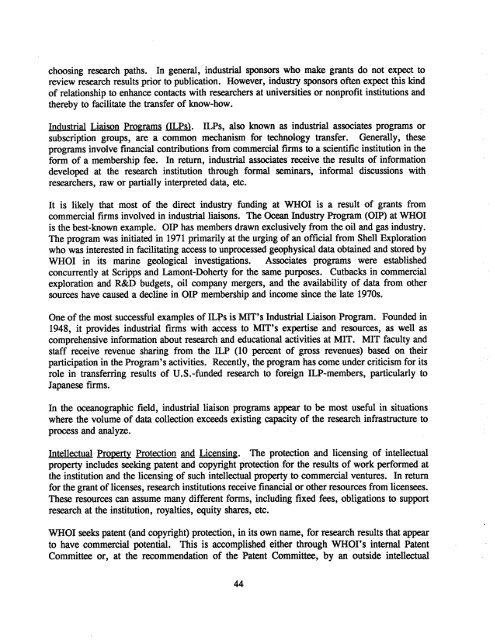WHOI-90-52
WHOI-90-52
WHOI-90-52
Create successful ePaper yourself
Turn your PDF publications into a flip-book with our unique Google optimized e-Paper software.
choosing resech paths. In general, industral sponsors who make grats do not expet to<br />
review resech results prior to publication. However, industr sponsors often expet this kind<br />
of relationship to enhance contacts with resechers at universities or nonprofit institutions and<br />
thereby to faciltate the transfer of know-how.<br />
Industrial Liaison Programs OLPs), ILPs, also known as industral assoiates programs or<br />
subscription groups, are a common mechanism for tehnology trsfer. Generaly, these<br />
programs involve financial contrbutions from commercial firms to a scientific institution in the<br />
form of a membership fee. In return, industral assoiates recive the results of information<br />
develope at the resech institution through formal seminars, informal discussions with<br />
resechers, raw or parally interpreted data, etc.<br />
It is likely that most of the direct industr funding at <strong>WHOI</strong> is a result of grants from<br />
commercial firms involved in industral<br />
liaisons. The Oc Industr Program (OIP) at <strong>WHOI</strong><br />
is the best-known example. OIP has members drawn exclusively from the oil and gas industr.<br />
The program was initiated in 1971 primarly at the urging of an official from Shell Exploration<br />
who was interested in facilitati~g access to unprocsse geophysica data obtaned and stored by<br />
<strong>WHOI</strong> in its marne geologiCa investigations. Assoiates programs were established<br />
concurrently at Scripps and Lamont-Doherty for the same purpses. Cutbacks in commercial<br />
exploration and R&D budgets, oil company mergers, and the availabilty of data from other<br />
sources have cause a decline in OIP membership and income since the late 1970s.<br />
One of the most successful examples of ILPs is MI's Industral Liaison Progra. Founded in<br />
1948, it provides industral firms with access to MI's expertse and resources, as well as<br />
comprehensive information about resech and educational activities at MIT. MIT faculty and<br />
staff receive revenue sharng from the ILP (10 percent of gross revenues) base on their<br />
paricipation in the Program's activities. Recntly, the progra has come under criticism for its<br />
role in transferrng results of U.S.-funded resech to foreign ILP-members, parcularly to<br />
Japanese firms.<br />
In the ocographic field, industrial liaison programs appe to be most useful in situations<br />
where the volume of data collection exces existing capacity of the resech infrastrcture to<br />
procss and analyze.<br />
Intellectual Property Protection and Licensing. The protetion and licensing of intellectual<br />
propert includes seking patent and copyright protection for the results of work performed at<br />
the institution and the licensing of such intellectual property to commercial ventures. In return<br />
for the grat of licenses, resech institutions recive financial or other resources from licenses.<br />
These resources ca assume many different forms, including fixed fees, obligations to support<br />
resech at the institution, royalties, equity shares, etc.<br />
<strong>WHOI</strong> seks patent (and copyright) protetion, in its own name, for resech results that appe<br />
to have commercial potential. This is accomplished either through <strong>WHOI</strong>'s internal Patent<br />
Committe or, at the recommendation of the Patent Committe, by an outside intellectu<br />
44
















